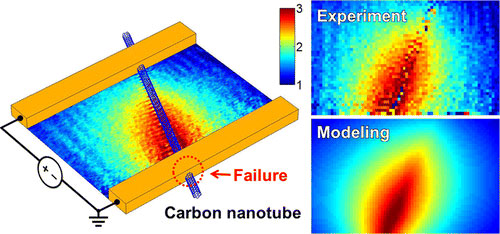| Oct 03, 2013 |
A new method to diagnose nanoelectronic components
|
|
(Nanowerk News) Researchers at the University of Maryland have developed a new method to examine
the electric potential distribution of a prototype single-carbon-nanotube device consisting of a suspended carbon nanotube (CNT) with source and drain electrodes, using off-axis EH and finite element calculations.
|
|
Reporting their findings in Nano Letters ("Diagnosing Nanoelectronic Components Using Coherent Electrons") they demonstrat that two differently resistive contacts gives rise to asymmetric features of the phase shift, and thus can be distinctly identified and quantified.
|
 |
| The uneven resistivity of different contacts can cause an asymmetric electron holography phase shift, which can readily be identified and quantified. (©ACS)
|
|
Using this method, it is possible to quickly debug a localized connection failure and detect latent misbehavior on the real device level with a spatial resolution of 10 nm or less.
|
|
Moreover, the method makes use of a direct and real-space measurement of the electrostatic potential without reliance upon a metallic physical probe that may be susceptible to variations in the local work function.
|
|
This approach can be broadly applicable to understanding and diagnosing a variety of nanodevices based on many other nanostructures, such as silicon nanowires and graphene.
|

